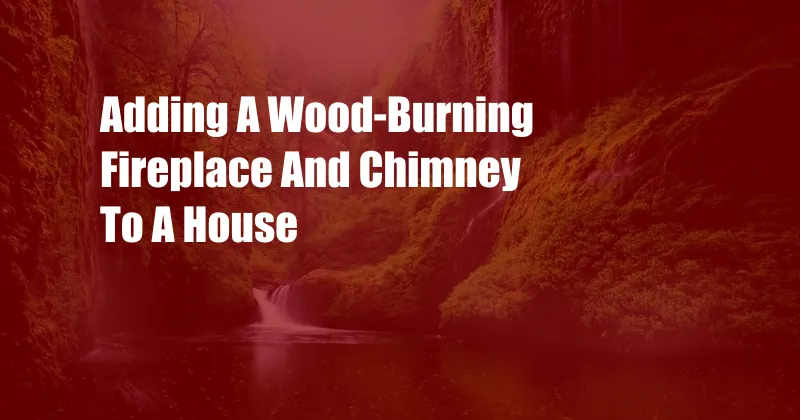
The Warmth and Charm of a Wood-Burning Fireplace and Chimney: A Comprehensive Guide
As the crisp autumn leaves fall and the evening breeze turns chilly, there’s nothing quite like gathering around a crackling wood-burning fireplace. For centuries, fireplaces have been the heart of homes, providing warmth, ambiance, and a sense of cozy contentment. If you’re considering adding a wood-burning fireplace and chimney to your home, embarking on this project can transform your living space into a haven of warmth and charm.
A wood-burning fireplace is not merely a source of heat; it’s an evocative centerpiece that evokes memories, sparks conversations, and creates a welcoming atmosphere. Whether you’re enjoying a romantic evening by the fire or simply seeking solace on a cold winter night, a wood-burning fireplace brings a touch of magic to any home.
Understanding the Anatomy of a Wood-Burning Fireplace and Chimney
Fireplaces have a long and fascinating history, dating back to ancient civilizations. The earliest fireplaces were simple pits dug in the ground, but over time they evolved into elaborate structures adorned with decorative elements.
A modern wood-burning fireplace consists of several key components:
- Firebox: The firebox is the heart of the fireplace, where the wood is burned. It is typically made of firebrick or heat-resistant metal.
- Chimney: The chimney is a vertical duct that carries smoke and gases from the firebox to the outside. It is usually made of brick, stone, or metal.
- Flue: The flue is the opening at the top of the chimney through which smoke and gases escape.
- Damper: The damper is a plate that can be opened or closed to control the airflow through the fireplace.
- Hearth: The hearth is the non-combustible floor area in front of the fireplace.
Choosing the Right Fireplace and Chimney for Your Home
When selecting a wood-burning fireplace and chimney for your home, there are several factors to consider:
- Fireplace type: There are two main types of fireplaces: traditional and zero-clearance. Traditional fireplaces are built on-site using bricks or stone, while zero-clearance fireplaces are prefabricated units that can be installed in any room.
- Chimney type: There are two main types of chimneys: masonry and prefabricated. Masonry chimneys are built on-site using bricks or stone, while prefabricated chimneys are made of metal and are typically used for zero-clearance fireplaces.
- Size and location: The size and location of the fireplace and chimney will depend on the size of your home and the layout of your living space.
- Building codes: Before installing a wood-burning fireplace and chimney, check with your local building department to make sure that you comply with all applicable building codes.
Installing a Wood-Burning Fireplace and Chimney
Installing a wood-burning fireplace and chimney is a complex and potentially hazardous project. It is important to hire a qualified professional to do the job safely and correctly.
The installation process typically involves the following steps:
- Planning: The first step is to plan the location and size of the fireplace and chimney.
- Foundation: A foundation is built to support the fireplace.
- Firebox and chimney construction: The firebox and chimney are built using bricks, stone, or metal.
- Hearth installation: The hearth is installed in front of the fireplace.
- Damper installation: The damper is installed at the top of the chimney.
- Finishing: The fireplace and chimney are finished with a decorative facade.
Tips and Expert Advice for Enhancing Your Wood-Burning Fireplace Experience
Once your wood-burning fireplace and chimney are installed, there are several things you can do to enhance your experience:
- Use seasoned firewood: Seasoned firewood burns more efficiently and produces less smoke.
- Start the fire properly: Use kindling or newspaper to start the fire, and gradually add larger pieces of wood.
- Control the airflow: Use the damper to control the airflow through the fireplace. This will help you regulate the fire’s intensity and prevent smoke from entering your home.
- Clean the chimney regularly: A dirty chimney can be a fire hazard. Have your chimney cleaned by a qualified professional at least once a year.
- Be careful when using the fireplace: Never leave a fire unattended. Keep children and pets away from the fireplace.
By following these tips, you can enjoy the warmth and ambiance of your wood-burning fireplace for many years to come.
FAQs About Wood-Burning Fireplaces and Chimneys
Q: What is the best type of wood to burn in a wood-burning fireplace?
A: The best type of wood to burn in a wood-burning fireplace is seasoned hardwood, such as oak, maple, or hickory.
Q: How often should I clean my chimney?
A: You should have your chimney cleaned by a qualified professional at least once a year.
Q: What is the difference between a traditional fireplace and a zero-clearance fireplace?
A: Traditional fireplaces are built on-site using bricks or stone, while zero-clearance fireplaces are prefabricated units that can be installed in any room.
Q: How much does it cost to install a wood-burning fireplace and chimney?
A: The cost of installing a wood-burning fireplace and chimney will vary depending on the size and complexity of the project.
Conclusion
A wood-burning fireplace and chimney can be a beautiful and functional addition to any home. By carefully planning and installing your fireplace and chimney, and by following a few simple tips, you can enjoy the warmth and ambiance of a wood-burning fire for many years to come.
Are you interested in learning more about wood-burning fireplaces and chimneys? If so, please leave a comment below.